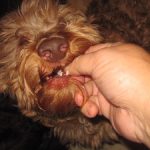
Do you have an intact female dog or live with one who is currently experiencing an unpleasant heat cycle? Being in heat can be a great source of discomfort and stress for female dogs, and it’s not unusual for them to get a little sick.
Dogs in heat will likely vocalize more, cry a bit, bleed, and generally behaviour differently. This is usually very unpleasant for both the pet parent and the dog, but you can help your dog feel much better if you have a better understanding of the entire process.
What do we mean by “being in heat”?
When a dog is in heat, it means that she is either getting ready to reproduce or is already fertile. Being in heat is a normal part of an intact female dog’s life, it indicates that the dog is now sexually mature and ready to mate to breed young puppies. Female dogs typically experience their estrus cycle or “will be in heat” as few as one or twice a year, but for some breeds it can be as frequent as every 4 months.
How do you know if your dog is in heat?
During their heat period, dogs will experience both physical and hormonal changes, and the changes in their hormones will also trigger certain behavioural changes. All these changes are clues that tell you if your female dog is in heat. A dog’s estrus cycle is divided into their 3 stages and each stage is characterized by certain physical and behavioural changes.
Here are what to expect from a female dog in heat;
- The first stage of the estrus cycle is called proestrus and is characterized by swollen vulva, frequent urination, bloody discharge from the vulva, tail tucking and excessive licking of the genital area. You may notice that she becomes more nervous and clingy.
- The second stage of the estrus cycle (which is called estrus) is characterized by clear or straw-coloured discharge from the vulva, tail flagging and flirty behaviour towards male dogs because at this stage she is fertile and ready to mate.
- The final stage is called the diestrus, and in this stage the dogs will no longer be fertile or interested in mating. The vaginal discharge will cease completely and the vulva will shrink to its normal size.
How long does “being in heat” last?
A dog’s estrus cycle will last for 2 to 4 weeks. The entire heat stage will last for about 28 days, the second stage of the heat cycle when the dog becomes fertile and ready to mate lasts for a total of 3 to 9 days.
The length of a dog’s estrus cycle and at what age it starts varies from breed to breed; small dog breeds usually mature faster and will experience their first heat cycle at about 6 to 8 months while large dog breeds will become sexually mature from around 12 to 18 months or 24 months for very large breeds.
Small dog breeds will also have their estrus cycle every 4 months while large dog breeds have theirs every 8 or 12 months; and how long each heat cycle lasts will vary according to dog breed and size.
Why might a dog in heat be vomiting?
Vomiting is normally not one of the symptoms of a dog in heat, however it may not be unusual for your female dog to experience minor digestive distress due to the changes in her hormones.
A dog in heat may suffer mood swings and mild stomach upset, but severe symptoms like bouts of vomiting followed by lethargy and lack of appetite require the attention of a vet. Vomiting, lethargy and frequent urination are all symptoms of pyometra, which is an infection of the uterus.
Pyometra can be fatal if left untreated, any dog with this condition requires urgent veterinary care and the cure is emergency removal of the uterus. The most common causes of vomiting in dogs is dietary indiscretion, organ damage or parasitic infections like worms.
Therefore, a dog vomiting while in heat may be due to an underlying disease or dietary indiscretion and not solely due to the heat cycle. However, ensure you consult your vet if you observe that your dog’s condition is very unusual.
Why might a dog in heat suffer from diarrhea?
Sometimes female dogs get a little sick during or after their heat cycle due to the hormonal change in their bodies. They may have slight gastrointestinal upset, but symptoms like vomiting or diarrhea are very unusual since these are not normally among the most common symptoms of a dog’s estrus cycle.
The estrus cycle is usually stressful for dogs, and confining your young lady may also increase her stress level which may in turn trigger a minor gastrointestinal upset.
And if there is loose bowel movement, expect symptoms to last for only a day and anything longer or more severe with other disturbing signs like fever, decreased appetite, lethargy, increased thirst, pus from the vulva, can be due to a life-threatening uterine infection; pyometra.
How else might the behaviour of a dog in heat change?
Here are some of the behavioural changes to look out for in a dog in heat;
Anxiety: this is one of the first behavioural changes you will notice in your female dog at the onset of her estrus cycle. Bitches get anxious during this period because they can sense the changes going on in their bodies and this makes them a little nervous, and they may become more clingy to their owners.
Decreased energy: during the first phase of the heat cycle, some female dogs will have low energy levels and become extra lazy. This isn’t the case for all bitches, while some will become extra restless and nervous, some others will be very lazy. The idea is to look for a significant change towards one direction or a radical change in behaviour; that is if your dog was usually clingy and affectionate, she may become snobbish and grumpy while a usually high-spirited dog may become very lazy.
Increased appetite: dogs in heat are also known to have more appetite for food, this is because her body is gradually getting prepared for a potential pregnancy and needs to have enough nutrients for the little puppies when they finally come. This can also be the other way round, some female dogs will have reduced appetite and eat only very little.
Tail movement: while in the first phase of the heat period, female dogs will tuck their tails and aggressively fight off any advances from male dogs. But in the second estrus stage, female dogs will wag their tails and flirt with male dogs to get their attention and communicate their desire to mate.
How can you help your dog in heat to feel better?
Being in heat can be confusing and unpleasant for any teenage dog, and she may become extra cuddly or a little erratic. If you decide to leave your female pup intact, here are some tips to help her get through her estrus cycle.
Pay more attention: during her heat period, your dog may not ask for your attention, especially if she’s being grumpy, but she certainly needs it. You will have to ensure she’s properly cleaned up when she expels liquid discharge to prevent getting your living space messed up. If you have a long-haired breed, consider trimming the hair surrounding her genital area, you may also need to get her some comfortable dog diapers to contain the discharge.
Give her more treats: if your dog eats very little during this period, then she will need some extra treats to ensure she keeps getting the healthy amount of calories her body needs to function properly and keep her energy up. And give her toys or bones she can chew on to help stabilize her mood.
Take her on more walks: if our dog becomes restless during her heat period, then it will help if you take her on daily walks with a leash to help her work off some anxiety and relax better. Make sure you don’t go out with a leash to prevent her from running off, or use a Tractive GPS tracker.
What are the advantages of having a female dog neutered?
If you are wondering whether to get your bitch spayed, here are some good reasons why you should.
It prevents pyometra: pyometra is a deadly infection of the uterus. About 25% of intact middle-aged female dogs will have this condition where the uterus is filled with toxic pus which can be fatal if not surgically removed. This condition can be completely prevented if the dog is spayed.
It increases the lifespan of your dog: having your dog spayed will contribute to a healthy, happier and longer life. It’s been scientifically proven that neutered pets tend to live longer than intact ones because they are less susceptible to certain infections, tumours and behavioural problems. Female dogs spayed before their first estrus cycle are less likely to have mammary cancer.
It prevents heat cycle and pregnancy: despite that heat cycle and pregnancy are both natural parts of the life of female dogs, they can both be sources of great stress for bitches. Being in heat is neither fun for the dog nor the owner, and getting your dog spayed will save you two from such unnecessary stress.
Spaying can also have negative effects, dogs who are spayed at the wrong age or without proper safety precautions can develop some unpleasant life-long consequences. Spaying at a very young age can cause some health conditions such as hip dysplasia, torn ligament, bone cancer, and urinary incontinence. So ensure your dog is at the right age for the surgery; it varies for different dog breeds.
Closing Thoughts
“Being in heat” can be compared to the menstrual cycle in human females, but in dogs it’s called the estrus cycle, and it doesn’t occur nearly as frequently as in humans. A dog in heat will experience certain changes in her hormones which will trigger both physical and behavioural changes.
She may get a little sick or erratic and will need special care to get through this period. A female dog will experience the heat cycle throughout her life and getting her spayed at the right age is the only way to ensure she lives a healthy and happy life without the stress of the heat period.





